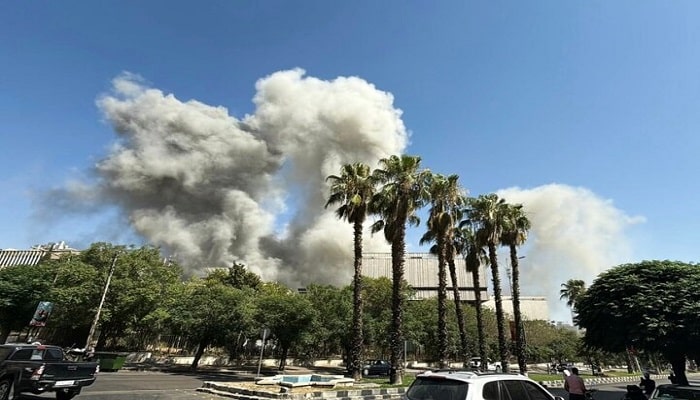PNN – The Israeli regime has targeted Syrian territory with a massive military aggression, even though Golani had previously announced his agreement to normalize relations with Zionist regime, while taking a commemorative photo with Trump.
After the Golani regime came to power, the mainstream media framed the damaged and burned image of former Syrian President Bashar al-Assad atop a government building, signaling the beginning of a new era for war-torn Syria and a move toward “democracy,” “freedom,” and “development”!
Yesterday’s terrorists, some of whose main leaders were also on the blacklist of the United States and European countries, suddenly became “leaders of freedom” and a model for anti-American countries to transition to a new future! While reporters’ cameras were showing the joy of Assad’s opponents, Israeli army forces occupied the remaining parts of the Golan Heights and began a massive crackdown on the Syrian army in various parts of the country. Syria today may have the support of a large portion of regional and extra-regional countries, but without the necessary defense capabilities, it has become an “easy target” for the Zionist regime’s war machine.
What happened?
On the evening of Wednesday, July 16, 2025, Israeli Defense Minister Yisrael Katz announced the start of the painful Israeli attacks on Syria! The incident began when Tel Aviv, using the sentiments of the Druze living in occupied Palestine as an excuse, introduced itself as the main supporter of Druze rights in southern Syria and warned the Golani forces that any heavy military-security presence in the area would be met with a reaction from Tel Aviv. The promotion of this narrative caused divisions among the Druze, with some of them recognizing Tel Aviv as their true supporter in the region.
Read more:
Jolani: Tel Aviv’s intervention pushed Syria to a dangerous stage
Now, some Druze leaders are calling for good relations with Damascus, but others, such as Sheikh Hekmat al-Hajri, have called for resistance against government forces and have asked for help from Tel Aviv; an approach that not all Druze leaders like. For example, Walid Jumblatt, one of the major political leaders of the Druze movement, who had also rejected the Israeli narrative in the dubious “Majdal al-Shams” incident, strongly condemned the military actions of the Israeli army in southern Syria.
The new round of clashes between the Golani regime forces and the Druze occurred as the Golani regime intended to expand its influence by sending its forces to the Sweida province. At the same time, Israel warned the Golani forces that they would be attacked if they entered the area.
Normalization with a taste of war
For the rulers of Turkey, Saudi Arabia, and Qatar, Golani symbolizes a return to the Levant and the expansion of their influence in the Eastern Mediterranean. From the first days of Golani’s rise to power, they promised to quickly lift sanctions on the country and pave the way for Damascus’ return to the international community.
The aforementioned countries also promised to help the new Syrian regime rebuild the war-torn country in the shortest possible time. On the other hand, the new rulers of Damascus also promised to show great flexibility, without considering the rights of the Syrian people, such as the return of the Golan Heights to the country, to normalize relations with the Zionist regime, and through close security cooperation with Washington and Tel Aviv, to become part of the security project of weakening the resistance on the Arab Eastern Front.
After the series of developments mentioned above, most experts agreed that the normalization of Damascus-Tel Aviv relations was imminent, and the only difference for them was the timing of this event and some of the concessions offered to Syria. Last week’s developments, however, changed all these assumptions and caused speculation about the political future and even the preservation of Golani’s life to become the main headlines in the media, instead of Abraham’s peace!
Confronting a country without an army
After the fall of the central government in Damascus, many expatriate political activists shouted “cries of victory!” This propaganda campaign peaked when Golani met with Donald Trump in Riyadh, and shortly after, the shadow of “Caesar’s sanctions” was lifted from the country. Behind the cameras, however, what was hidden from public opinion was the more than 500 Israeli army attacks on Syrian defensive and offensive facilities, which resulted in the destruction of a large part of the Arab country’s air, naval, defense, and radar forces.
At the same time, the Israeli army forces, violating the 1974 agreement, occupied the entire Golan Heights, including Mount Hermon, and deployed their special forces in the Sweida province. The recent aggression by Israeli warplanes on Damascus, targeting vital centers such as the Ministry of Defense building, the presidential palace, and attempting to assassinate senior officials of the Golani regime, was not unexpected or strange. The Israeli regime’s attack on Syria and Netanyahu’s attempt to consolidate the regime’s power throughout West Asia occurred while Golani had previously announced his agreement to normalize relations with Tel Aviv, while taking a souvenir photo with Trump.

